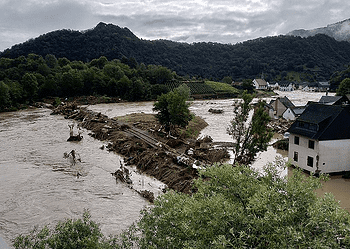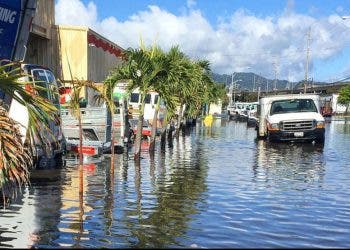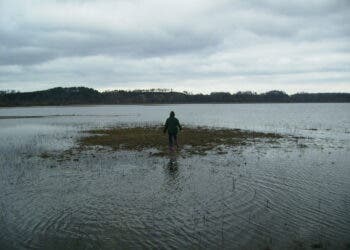
At first glance, Beaufort, North Carolina, looks like any other sleepy seaside town. But Beaufort has a problem that went largely underreported: flooding. Over and over, the town gets flooded, and most of the water isn’t showing up in the official data.
When researchers set up land-based sensors in Beaufort (and two other coastal towns), they found that the standard tide gauges (long trusted by city planners and engineers) massively underestimate how often roads actually flood. In Beaufort, real flooding occurred over 100 days in a single year, the tide gauge only picked up nine.
Sensors Tell a Different Story
Let’s rewind a bit. Tide gauges are installed along coastlines or on ocean platforms. They use sensors to make a continuous record of water height, by the minute, hour, or day. The problem with tide gauges is that they measure water levels in the ocean or estuaries, not on land.
If you live in a coastal area, you probably don’t care if the sea is up a foot, unless it’s flooding your street. But tide gauges don’t know what’s happening on the pavement or in backyard ditches. Of course, there’s a correlation between how the water swells and how flooding occurs in coastal towns. But that correlation doesn’t seem to be as strong as we thought.
A team of researchers led by Miyuki Hino at the University of North Carolina deployed small, inexpensive, open-source sensors right where the flooding actually hits: in storm drains and along roads. They installed the sensors in the places that residents said were most likely to get flooded.
Each sensor measured water depth and snapped time-stamped photos. In total, they documented flooding on 26 days in Beaufort, 65 in Carolina Beach, and a whopping 128 days in Sea Level — a rural, low-lying hamlet living up to its name.
“Government agencies and researchers use data from tide gauges to measure water levels in coastal areas, then use that data to estimate flood frequency in the region,” says Hino, corresponding author of a paper on the study and assistant professor of city and regional planning at UNC.
“Those estimates are used both to assess how often flooding has taken place and to predict how often flooding may take place in the future. However, our study shows that this approach does not accurately capture how often flooding takes place or how long those floods last.”
Hard To Estimate
NOAA’s high-tide flood threshold, derived from nearby tide gauges, registered only 1 to 9 days of flooding in those same areas. You may say “just lower the threshold” but that’s not how flooding works.
Flooding is messy. It’s caused not just by rising tides but by local rain, poor drainage, clogged stormwater systems, groundwater, and how flat the land is. These drivers are hyper-local. Tide gauges, by contrast, are spaced miles apart and don’t factor in rain or infrastructure failures.
For example, in Beaufort, the tide gauge and land sensor were just 0.6 miles apart — but the sensor caught floods the gauge didn’t. Even lowering the gauge’s threshold to match the road’s elevation still missed many events. Worse, it triggered false alarms, counting “floods” when no water touched the pavement.

This is especially a problem in rural areas. In Sea Level, floods sometimes last longer than 15 hours; sometimes, they last overnight. They can cut off roads, school buses, and emergency services, and can also become a hazard. The reason is that rural roads and communities have simpler drainage infrastructure and less investment in sewage. Because floods are underreported, many necessary investments are also delayed, leaving communities at risk.
This will only become a bigger problem with rapid climate change.
“Due to sea-level rise, we’re now seeing flooding in coastal areas outside of extreme storms like hurricanes,” says Katherine Anarde, co-author of the paper and an assistant professor of coastal engineering at NC State.
“There can be flooding during everyday rain showers or at high tide on sunny days. It’s important that the methodology we use to monitor and predict flooding reflects this reality, since sea-level rise means these flooding events are going to become even more common. Our research shows you need land-based measures of flooding to capture the burden on coastal residents, which can inform policy and planning decisions moving forward,” Anarde says.
Global Problems, Open-Source Solutions

This isn’t just a North Carolina story.
In fact, similar studies using land-based sensors in New York City and Key West have found the same pattern: tide gauges routinely miss street-level floods. The odds are hundreds of millions of people living in coastal areas suffer similar problems. And it’s not just about counting how many days the road is wet. Chronic flooding changes how people live. If flood frequency is being underestimated by an order of magnitude, we’re not just lowballing risk — we’re misallocating billions in adaptation funds.
The sensors in the study are low-cost. Each one is about a few hundred bucks. They’re open-source. They can be built by municipalities or even high schools with basic tools and programming knowledge. That means cities and towns don’t need to wait for federal funds or complex equipment.
This opens the door for citizen science. This can enable smarter flood insurance and predictive modeling that actually matches reality. In time, this can enable better city planning anywhere tides, rain, and asphalt collide.
“Every community is unique, so there’s no one-size-fits-all solution,” says Hino. “But with more accurate data, we can help communities assess what response strategy is best for them, now and in the future.”
We need more eyes on the ground. This means more sensors and more honesty about what’s coming. Because if water is flooding your street 128 days a year, that’s not just a nuisance. That’s a slow-motion disaster.
“More accurate information on coastal flooding can inform where and how we invest resources in building more resilient communities,” says Anarde. “It’s hard to design an efficient solution when you don’t know the scope of the problem.”






